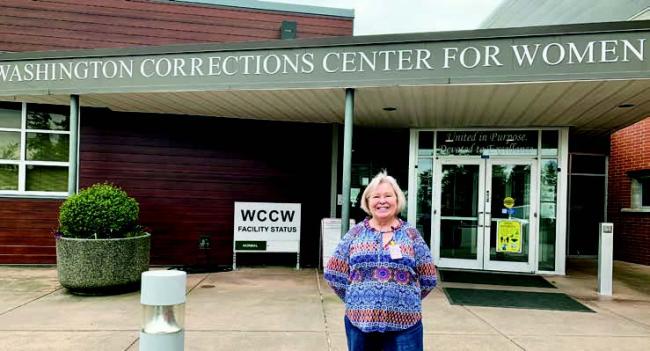Sharon Kirkpatrick pauses outside the Washington Corrections Center for Women, where
every month she and Sharon Bruner-Rowe lead a support group that is part of the Washington
State Department of Veterans Affairs Women Veterans Advisory Committee’s outreach
efforts. Together, the two facilitators are known as “The Sharons.” | Photo courtesy of Sharon
Kirkpatrick
By Sharon Kirkpatrick
Once a month, behind the gates of Washington Corrections Center for Women (WCCW), a group of women are invited through the facility “callout” to participate in a “veterans outreach session.” A database in DOC identi!es veterans who have served their country. As the leader of that group, that information is shared with me.
Did you serve in the military at any time in your life? If so, you are a veteran. The question “Did you serve?” is often the best way to determine if someone may
have VA benefits and opportunities they did not know about. Many women who served think being a veteran is de!ned as 20 years and retirement in the Armed Forces. Not so.
This is what starts a powerful conversation at the Washington Corrections Center for Women (WCCW) among a group of 12 to 15 incarcerated women led by me and
Sharon Bruner-Rowe. Known as “The Sharons,” we are members of the Washington State Department of Veterans Affairs Women Veterans Advisory Committee. The WCCW support group is part of the Committee’s outreach efforts to reach all women veterans in Washington state.
Under the leadership of Committee chair Shellie Willis, support from American Legion Post 204 Post Commander Carrol Stripling, and Department of Corrections liaison
Derik Roberson, we have been able to identify and serve over 300 women over a period of 10 years.
The women come to the monthly group meeting at WCCW to learn about their benefits, such as employment, housing, health benefits and education. Over the years, a
few women have been ashamed, uncertain, or unsure if they should attend, but we encourage their participation. I tell them, “You signed a contract; you joined with good faith to serve your country, and that is what we call a veteran.” When we initially get a woman into the group, automatically there are tears, because we are the first ones to say, “Thank you for your service. You were a veteran before you were an inmate.” No one has ever said that to them.
I have spent decades volunteering and teaching in women’s prisons and had a passion for the incarcerated population that quickly spread to establish a group inside the state’s two women’s prisons. The group prepares participants for reentry, which may be six months to !ve years or more. Each month, we have a topic of interest: anything from military sexual trauma to nontraditional career paths. As a veteran’s release date grows near, the partnering agencies and organizations work together to build a thorough reentry plan and set it in motion. This plan includes seeing a service officer, enrolling in VA health care, or seeking counseling for mental health issues.
For the most part, however, this group is a labor of love with partners piecing funds together from multiple sources. Lacking funding, the program still does not have a formal tracking system to monitor its successes, but, anecdotally, our recidivism rate is 0%. The women who have been able to access their benefits have had a
successful transition and are moving on with rebuilding their lives. They do not re-offend and end up back in the system. Many success stories exist. Due to the shame and stigma associated with justice involvement, it is often challenging to get incarcerated veterans to identify as veterans. Although this is true for many in the justice system, it seems more common with women than men. Women go inward with shame and guilt, while men go outward with, “I was a veteran!”I believe that women veterans can gain a sense of self-worth and service. We work to maximize visibility through the distribution of an in-prison newsletter when possible and talking to as many incarcerated women as possible. Growing visibility outside the facilities might help. Several news outlets have created stories about
the program.
I have seen fellow American Legion members grow more vocally supportive of justice-involved women veterans. In fact, all-women American Legion Post 204 agreed to sponsor membership for the incarcerated women in the program, providing them access to benefits assistance and a national and local veterans’ network.
I am hopeful that with increased attention, justice-involved women veterans may !nd it easier to be proud of their veteran status and re-enter society with their heads held high.


